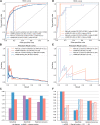Detection of diabetic patients in people with normal fasting glucose using machine learning
- PMID: 37674168
- PMCID: PMC10483877
- DOI: 10.1186/s12916-023-03045-9
Detection of diabetic patients in people with normal fasting glucose using machine learning
Abstract
Background: Diabetes mellitus (DM) is a chronic metabolic disease that could produce severe complications threatening life. Its early detection is thus quite important for the timely prevention and treatment. Normally, fasting blood glucose (FBG) by physical examination is used for large-scale screening of DM; however, some people with normal fasting glucose (NFG) actually have suffered from diabetes but are missed by the examination. This study aimed to investigate whether common physical examination indexes for diabetes can be used to identify the diabetes individuals from the populations with NFG.
Methods: The physical examination data from over 60,000 individuals with NFG in three Chinese cohorts were used. The diabetes patients were defined by HbA1c ≥ 48 mmol/mol (6.5%). We constructed the models using multiple machine learning methods, including logistic regression, random forest, deep neural network, and support vector machine, and selected the optimal one on the validation set. A framework using permutation feature importance algorithm was devised to discover the personalized risk factors.
Results: The prediction model constructed by logistic regression achieved the best performance with an AUC, sensitivity, and specificity of 0.899, 85.0%, and 81.1% on the validation set and 0.872, 77.9%, and 81.0% on the test set, respectively. Following feature selection, the final classifier only requiring 13 features, named as DRING (diabetes risk of individuals with normal fasting glucose), exhibited reliable performance on two newly recruited independent datasets, with the AUC of 0.964 and 0.899, the balanced accuracy of 84.2% and 81.1%, the sensitivity of 100% and 76.2%, and the specificity of 68.3% and 86.0%, respectively. The feature importance ranking analysis revealed that BMI, age, sex, absolute lymphocyte count, and mean corpuscular volume are important factors for the risk stratification of diabetes. With a case, the framework for identifying personalized risk factors revealed FBG, age, and BMI as significant hazard factors that contribute to an increased incidence of diabetes. DRING webserver is available for ease of application ( http://www.cuilab.cn/dring ).
Conclusions: DRING was demonstrated to perform well on identifying the diabetes individuals among populations with NFG, which could aid in early diagnosis and interventions for those individuals who are most likely missed.
Keywords: Diabetes risk prediction; Machine learning; Missed diagnosis; Normal fasting glucose.
© 2023. BioMed Central Ltd., part of Springer Nature.
Conflict of interest statement
The authors declare that they have no competing interests.
Figures






References
-
- Federation ID . IDF Diabetes Atlas. 10th 2021. - PubMed
-
- Enzo B, Maddalena T, Marco D, Daniela T, Vittorio C, Corinna B, et al. Chronic complications in patients with newly diagnosed type 2 diabetes: prevalence and related metabolic and clinical features: the Verona Newly Diagnosed Type 2 Diabetes Study (VNDS) 9. BMJ Open Diabetes Res Care. 2020;8:e001549. doi: 10.1136/bmjdrc-2020-001549. - DOI - PMC - PubMed
-
- Susan van D, Beulens JWJ, Yvonne T. van der S, Grobbee DE, Nealb B. The global burden of diabetes and its complications: an emerging pandemic. Eur J Cardiovasc Prev Rehabil. 2010;17:s3-s8. - PubMed
Publication types
MeSH terms
Substances
LinkOut - more resources
Full Text Sources
Medical

